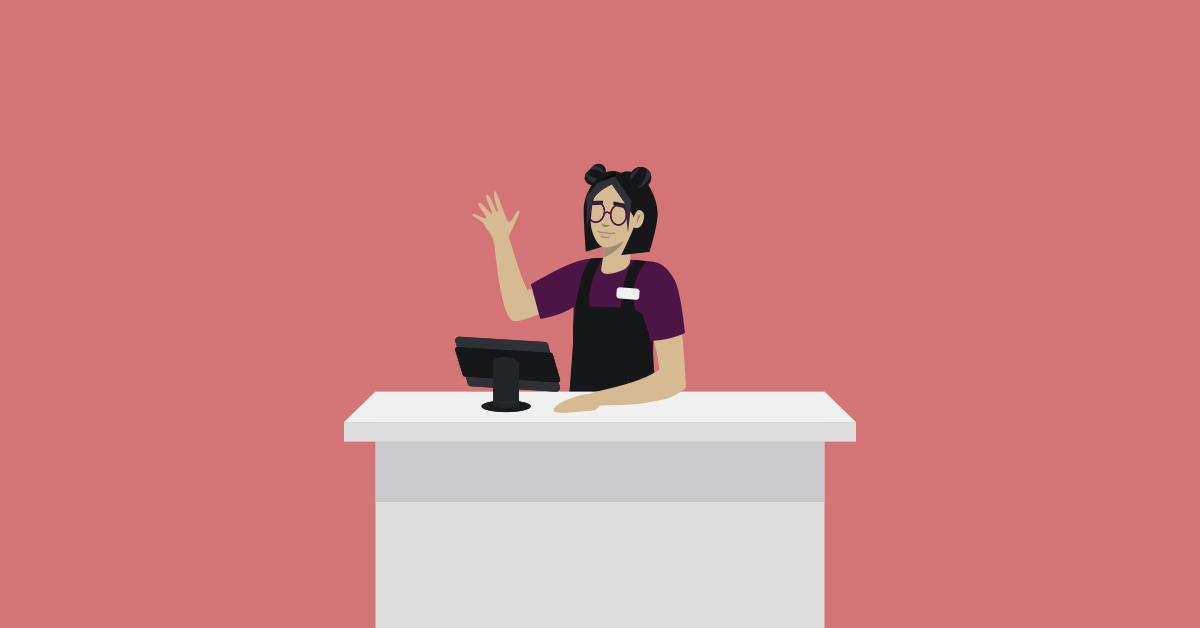
I distinctly recall a moment about a year ago. I was with some friends in Denver’s Cherry Creek neighbourhood, an area known for its upscale shopping, dining and hotels. One of my friends was getting married in a couple of months and stopped by the store where he and his groomsmen were getting their tuxedos.
He was greeted by name and with a cold beer. Handshakes and hugs all around.
When we left, I turned to my friend and asked, “Do you know them?” He said, “Yeah, they’re helping me with my tux.”
Their entire relationship was forged on a transaction, a customer-brand interaction. But it was authentic. I’m not in the market for a tux, but if I were, I’m sure that’d be my first stop.
How you greet your retail customers — along with your succeeding interactions with them — make lasting impressions. It’s a low-cost investment you can make to improve the customer experience and yield serious results.
One study shows that more than half of shoppers will return to your store because they’ve previously had “superior customer service.” Plus, that positive experience can help prevent shoplifting.
If you’re looking for techniques and examples on how to greet customers in retail, keep reading. We’ve put together some of the greetings and follow-up questions you and associates should try when interacting with shoppers.
Sales greeting techniques: why they’re important
Lack of acknowledgment from retail staff is one of shoppers’ top three biggest complaints about shopping — and it could be a contributing factor to why one Salesforce report found that only 32% visit stores because they enjoy the experience.
The greeting is the first impression that customers get of your brand, at least as it relates to that specific in-person experience. “A good customer greeting or even the absence of [one] is the first piece of the customer shopping environment,” says Chris Guillot, instructional designer of Retail Shift: Teaching Success on the Sales Floor™ and founder of Merchant Method. Guillot offers sales training for retailers and their employees. “They can get a sense of your message through greetings.” That greeting should set the stage for the experience your customer is about to have.
How do you greet customers in retail?
Vary sales greeting techniques and specific verbiage instead of speaking from a script every time. “It displays brand authenticity,” she says. “When retailers train sales associates to greet in a variety of ways, it allows not just the retailer, but also the associate to share the breadth and depth of your brand values.”
That’s not the only reason you should change it up. Guillot points out that this demonstrates authenticity, an awareness of what’s happening in-store, and authority and presence on the sales floor. That presence is crucial: Three-quarters of consumers place a lot of importance on being able to interact with sales staff when they need them, according to the Salesforce report cited before.
Plus, it feels personal. Each customer wants to hear their own greeting, and if everyone who walks in after them is greeted the same, it becomes impersonal. “Greetings let your guest know that you’re there to provide a great shopping experience,” Guillot says.
“[Greetings are] also important in sales conversion and loss prevention,” Guillot says.
Customer greeting techniques to use in your store
To help brainstorm ideas, Guillot buckets associate-customer interactions into four categories:
- Small talk
- Familiarity
- Commonality
- Orientation
Small talk
Small talk is a great way to break the ice and establish a friendly, human connection with shoppers. “Typically, small talk is for customers you don’t recognize,” Guillot says.
Small talk greetings and questions should invite two-way conversation. Avoid questions that can be answered with a yes or no — they can quickly lead to dead ends. Guillot says the relationship-building hinges upon that back-and-forth.
“It’s not necessarily the first question that is the most important question, or the first greeting the associate gives,” she says. “It’s the one that follows up the response that is more important, particularly when it comes to this bucket.” Those follow-up questions should be natural progressions of the conversation your associates are having.
Examples of small talk questions your associates can use on the sales floor:
- Are you enjoying your afternoon?
- How’d you hear about us?
- Did you watch the game last night? I stayed up to watch the end!
- How’s your day going?
- What are your up to the rest of the day?
- Who are we shopping for today?
Familiarity
Remember that experience I had with my friend at the tuxedo shop? That was under the category of what Guillot calls familiarity. “Familiarity is when you’ve seen a customer before,” she says. You’ve already established an initial relationship with a customer.
Now, it’s about nurturing that relationship. Demonstrate to your returning customers more than just that you remember them — show them that you’re getting to know them.
Salesforce also found that 64% of consumers want personalised offers from retail brands, while more than half will switch to another brand if you don’t integrate personalization into your communications.
“Regulars want to feel like they’re in a community and that they belong,” Guillot says. “I like to train my students to be friendly and personable, but not necessarily speak and communicate as they would with a friend.” She says to keep it to one or two sentences, as anything that goes overboard can actually negatively affect the experience.
Examples to get started with your familiarity interactions:
- What brings you in to see us again?
- It’s great to see you again.
- Welcome back! How’ve you been?
- Did you have a good weekend?
- Coming in for another ___ (insert their previous purchase)?
Commonality
This is when your associates represent the people behind your brand and share a piece of themselves (and thus, your brand) with customers. “Commonality establishes a relationship through something that is happening in common,” Guillot says.
Establishing commonalities with customers through your sales staff gives your customers something to connect with. A shared value, perception or even voice can make your brand relatable and instill trust.
Examples of questions and statements to say to in-store shoppers
- I like your ___ (shoes, scarf, coat, hairstyle, lipstick, etc.)
- Wow, how are you navigating that traffic?
- Are you managing to stay dry with all this rain!?
- Are you enjoying all the sun we’ve been having?
- Have been around to the corner to store X? It’s one of my favorites. (Follow up with What do you like about that store?)
Guillot’s tips on commonality:
- Be specific: Rather than asking ‘how about this weather?’ try something like ‘did you get outside to enjoy the warm weather we’ve been having?’ “You can show true engagement,” says Guillot of specificity.
- Be personal: Encourage sales associates to share a bit about themselves, through the lens of your brand. “Personal testimonials are important when you’re establishing commonality,” Guillot says. “And they definitely need to be true and helpful.”
- Be authentic: Consumers can sniff out inauthenticity in an instant. Customer-associate interactions should be authentic to both the brand and your staff.
- Be positive: Every interaction should be positive. Guillot gives an example, rather than saying ‘when will it stop raining; we can do anything!’ opt for ‘you’re more than welcome to stay in here as long as you need to stay dry.’ “That’s a good way to take commonality, which sometimes tends towards discomfort or inconvenience, and put a positive spin on it,” she points out.
Orientation
Orientation is essentially welcoming and familiarizing customers to the space in your store. These types of interactions direct customers to what they need and also help them feel comfortable while shopping.
Sometimes, customers will tell you exactly what they’re looking for. In that case, orientation is more straightforward: Guide those individuals to get exactly where they want to go. You could also offer helpful information they might not have thought of.
For example, if someone’s looking for running shoes in your sports apparel shop, you could also point out that that the running socks are buy-one-get-one, and available on your way to the shoe section.
Examples of orientation responses for the “I’m just looking” customer:
- Personally, I like to start in this part of the store and work my way around.
- Take your time to look around. Some people stay here for as long as 45 minutes just exploring.
After that initial engagement, check in with that customer, with things like:
- Would you like a basket?
- Can I free up your hands?
- How about I start a fitting room for you while you continue looking around?
- Would you like me to hold your cup of coffee at the counter so you can shop easier?
- Are you finding what you thought you would?
Seasonal
During notable shopping seasons (e.g., back to school, Mother’s Day, the winter holidays, etc), it’s helpful to have aave a seasonal greeting in your backpocket. Depending on the occasion, you can choose to weave in the following phrases or statements into your customer greetings:
- Happy holidays!
- Shopping for someone special?
- We’re having a special on seasonal products in-store.
Non-verbal best practices for greeting customers
The best customer greetings aren’t just about what you say. Several non-verbal factors can influence how well your greeting will be received. Consider the following.
Look the part
This goes without saying, but you and your associates must be as presentable as possible when facing customers. The more likeable your appearance is, the higher the chances that shoppers would respond favorably to your greeting.
The right look depends on your store. Someone working at a that sells formal office clothes would dress differently than someone at a toy store. Regardless of your dress code though, see to it that you’re wearing clean and pressed clothing. If makeup is required, ensure that your face and hair are touched up periodically throughout the day so you can keep your best foot forward.
Time your greeting properly
The timing of your greeting will affect how your spiel would land.In retail, it’s best to wait about 15 to 30 seconds after someone has walked in before you greet them. This gives them enough time to get their bearings and adjust to your store’s environment.Greet them too soon could lead to customer overwhelm, so ensure that you wait a bit before approaching them.
Be mindful of your body language
Your body language should feel open and welcoming. Keep your arms at your sides (rather than crossing them) and maintain a healthy amount of eye contact.Keep an appropriate distance between yourself and shoppers so as to not invade their personal space.
Continuing the interactions
In addition to the tips above, Guillot reiterates the importance of keeping the conversation going but being mindful of the customer’s preferences. “I like to take the cue from the customer,” she says. “Typically, sales associates are very attuned to what’s happening on the sales floor and the vibe.”
At the end of the day, it comes down to your intuition and noting social cues. “If it feels like you’re asking too much, you’re asking too much. If you feel like it’s been a long time since you checked in, you’ve waited a long time to check in.”
How can you “read” your customers? Consider:
- Body language
- Verbal cues
- Eye contact
Bear in mind that every person, and thus every customer, is different. “More than [one interaction] for someone who’s very introverted might be too much,” Guillot says. If a customer feels like they’ve been authentically and genuinely engaged, you can take their cue for back and forth conversation.”
Train your employees
At the end of the day, Guillot nods to the fact that the best sales associates are inherently good at interpersonal communications. There are some characteristics that you can’t teach. “A true customer sales associate likes to engage,” she says.
However, you can give associates knowledge of sales greeting techniques to enhance their skills and provide a brand-authentic customer experience. “We need to trust that they can be empowered with the product knowledge and the brand values to make that engagement genuine,” says Guillot.
Retail Dive reports that almost one-third of retail employees don’t receive any formal training, and that includes sales greeting techniques. However, retail staff training is an area that would benefit from more attention, especially in relation to employing these in-store tactics. For example, the Salesforce report found that 44% of consumers usually know more about products than associates.
“It’s quite a catch-22 in that the more that we train people to be genuine, it almost becomes more disingenuine,” Guillot says. “When we’re pressuring people to be authentic, it comes across as inauthentic.”
But effective employee training is easier said than done. Retail Dive also reports that 35% of retail employees found their training to be “very effective,” and only 31% felt “extremely engaged” after their training.
Guillot has found one effective training technique: role-playing. “I think that retailers are really best served with experience-based training,” she says. “No one likes to role-play training activities, but that is exactly what makes them very effective and efficient, because it highlights confusion, misalignment and discomfort.” It puts your staff on the spot and replicates the real-life experience.
Guillot says to switch it up; role play with extroverted, introverted, suspicious and even rude customers to help your staff build the collective skillset and learn which responses are brand-appropriate.
Example: Guillot points to her local Seattle ice cream shop Molly Moon’s Homemade Ice Cream as a brand that has effectively trained associates — called Scoopers — to ask the right questions and make every customer experience positive. There’s almost always a line out the door. “I always feel genuinely greeted, even though the interactions are quick,” she describes. “[The Scoopers are] so friendly and have fantastic personable personalities. Even though the engagement is quick, I never feel like I’m being rushed.” Customers can taste as many ice cream flavors as they like, and there are visuals to keep you occupied during the wait. “By the time I get to an associate, I don’t feel frustrated and like I waited forever. I’m quite excited,” she says. “That quick but genuine engagement is a great way to cap my experience with the store.”
Employing effective sales greeting techniques
One straightforward way to effectively greet and interact with customers is to put yourself in their shoes. How would you like to be helped? Authentic, genuine interactions will almost always win over salesy practices.

News you care about. Tips you can use.
Everything your business needs to grow, delivered straight to your inbox.




